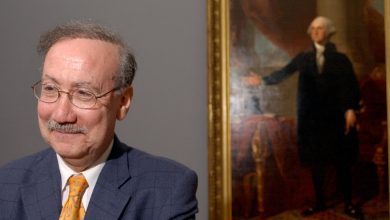In Bakersfield, Many Find a California They Can Afford

BAKERSFIELD, Calif. — For almost a decade, Edlin Gonzales was content to live in an aging studio apartment near Los Angeles’s bustling Miracle Mile, a canyon of tall office buildings, museums and restaurants in the middle of the city.
But when the pandemic ground life to a standstill, Ms. Gonzales, 33, decided that the time had come to try buying a home. “It’s like the American dream,” she said. “My parents were immigrants, so that’s the idea of success.”
In Los Angeles, though, the places she could afford would not have been much different from her apartment. So Ms. Gonzales, who works remotely for a medical research company, looked 100 miles north to Bakersfield. In January, she snagged a three-bedroom house with hardwood floors and a pool for $342,000, and joined a wave of in-state migration to one of the last affordable frontiers in California’s frenzied housing market.
For generations, Bakersfield has been the Golden State’s defiant outlier, a place Americans are unlikely to picture when they imagine California. At one of the city’s premier parks, a jogging trail winds along a bluff top with vistas not of the glittering sea, but of nodding pump jacks scattered across the vast, brown landscape of the Kern River Oil Field. Residents, many of whom proudly claim their descent from “Okies” fleeing the Dust Bowl and from migrant farmworkers from Mexico, joke that Bakersfield is the Texas of California.

An oil refinery in Bakersfield, where the petroleum industry is in decline. Credit…Alex Welsh for The New York Times
Now, amid a housing crisis that has helped halt the soaring population boom that made California the economic and cultural powerhouse it is, Bakersfield has emerged as unusual in another respect: It is growing, as homes are snapped up by people like Ms. Gonzales, searching for backyards, extra bedrooms or crosstown commutes measured in minutes, not hours.
Last year, when state demographers recorded California’s first population decrease, Bakersfield grew the fastest of the state’s 10 biggest cities, bringing its population to almost 400,000. Apartment vacancies are at historic lows. And while home values have increased significantly, experts say there aren’t yet the signs they’ve seen in other once-affordable refuges, such as Fresno and Sacramento, that the market is spiraling out of reach.
“It’s still a bargain, price-wise, compared to most places in California,” said Jenny Schuetz, an urban economist with the Brookings Institution.
The median price of a house in Kern County, the largely rural expanse that includes Bakersfield, was $340,000 in October, less than half the state number. In Riverside County, an inland community that has drawn thousands of people priced out of Los Angeles, it was $580,000.
But growth has inevitably brought change and questions about a civic identity defined by Bakersfield’s difference. And the influx of newcomers is arriving as the city’s historic industries, oil and agriculture, face existential challenges amid deepening climate crises.
Gov. Gavin Newsom has vowed to end fossil fuel production in California by 2045. Kern County is a state leader in solar and wind production, but local officials fear the oil industry will be gutted before renewable energy or other industries can replace the relatively high-paying jobs it provides.
Richard Gearhart, an associate professor of economics at California State University, Bakersfield, said the average pay for farmworkers is less than a third of the $2,000 per week that workers without college degrees can make in the oil fields.
The economic pinch is a political issue in a region where on-the-ground debates often belie a reputation for conservative partisanship.
“Show me the jobs, and show me the money,” said Rudy Salas, a Democratic state lawmaker from Bakersfield who is running for Congress in one of the nation’s most closely fought political battlegrounds. “If somebody’s making six figures right now in the energy sector, and you’re promising them a minimum wage job to install solar panels, they just want to be made whole.”
The debate has increased pressure to diversify the kinds of jobs available to residents and to market the city less as the southern gateway to California’s agricultural heartland than as an outer borough of Los Angeles.
When Andrae Gonzales first joined the Bakersfield City Council in 2017, he recalled, “the mantra was, ‘How do we do less with less?’” These days, he said, leaders are having a different conversation: “How do we improve amenities for people so that they can enjoy the city?”
Bakersfield’s core, he added, is uniquely poised for a revival, as young professionals drive up costs in urban centers across the country.
As evidence, Mr. Gonzales led a whirlwind tour of his downtown district, where for decades antique malls have filled the storefronts of the sturdy midcentury buildings that give its streets the look of a movie set.
He ducked into the nation’s last operating Woolworth’s luncheonette, where nostalgic diners were getting their final burgers before the building closed for renovations. The owners of the Five and Dime Antique Mall, which occupied most of the space, were retiring. Moneywise Wealth Management was moving in.
Mr. Gonzales also stopped outside the 17th Place Townhomes, whose clean, modern design might not garner a second look in another city. But to Anna Camp Smith, one half of the couple that developed and owns the complex, they’re a symbol of a promising future.
“Just for people to see that kind of dense, urban housing in their town is opening their minds to the idea that we can really, actually have an urban environment here,” she said on a recent afternoon, chatting over quinoa bowls and salad at a cafe across the street.
Two-bedroom townhouses rented for $1,800. They’re all occupied now, and Ms. Smith and her husband, the son of a city councilman, are developing another 49 units a couple of blocks away.
Autumn Paine, 45, said she and her husband wanted to find a place where they could largely abandon their cars; both had routinely spent hours in Bay Area traffic for work. During a visit to see Ms. Paine’s family in the spring of 2020, they stumbled upon the townhomes and were intrigued.
“We were like, ‘Should we do this?’” she recalled between sips at a bar marked by a 1950s-style neon sign, steps away from her front door. “Like, who moves to Bakersfield?”
Now, Ms. Paine, a lawyer, walks a block to an office near the courthouse. Her kids love their new home.
Developers are also scrambling to reel in would-be suburbanites.
Near the western edge of town, workers hammered away at Spanish Mission and modern farmhouse-style mansions in Stockdale River Ranch, a “master-planned community” developed by Bolthouse Properties, founded by one of the region’s most storied farming families.
And at a time when many of the state’s most desirable suburbs are hemmed in by development, like Irvine in Orange County, there’s lots of open land around Bakersfield.
Just south of Kern County and north of Los Angeles, Tejon Ranch Co., another historic landholder-turned-developer, has been fighting for decades to build a community of more than 19,000 homes. The effort got a boost this month when an environmental group agreed to drop opposition to the project in exchange for promises to make it greener.
Still, many are skeptical that Bakersfield will transform into another glossy, white-collar California exurb.
Kern County has among the nation’s worst air, in part, experts say, because of the presence of the oil and gas industry and in part because of topography. On a recent morning drive, bright sunshine in Los Angeles suddenly gave way to a thick, gravy-colored haze in Kern County.
Local elected leaders have clashed with state officials over pandemic restrictions, and the region has been one of the state’s hardest hit by illness and death.
Like the rest of the state, Kern County is also plagued by inequality. And experts say that wealthier newcomers could widen the gaps and push out the most vulnerable residents, in what has become a troubling cycle throughout the state.
“Gentrification is the wolf that lurks on my shoulder all the time,” said Lorelei Oviatt, Kern County’s planning director. “How do you lift the quality of the community while preserving the culture?”
Ultimately, Kern County is part of California — for better and worse, said Representative David Valadao, a Republican whose district encompasses part of Bakersfield. Mr. Valadao, who is facing a challenge from Mr. Salas, the state lawmaker, blamed state policies for the eye-popping gas prices, prohibitive housing costs and hiring difficulties for employers that have driven away some Californians.
“If they can find a way to save a lot more money on the cost of living, they’re not going to stay in California,” he said.
Ms. Gonzales, the recent transplant from Los Angeles, said that someday she might consider moving to another state. But not now.
She has loved being closer to her parents, who still live in Delano, the agricultural community where she grew up. And she is relishing spending time at home, hosting dinner parties or lounging by the pool, with company from her Doberman pinscher, Kali, who thrives in the big yard. Recently, a friend visited her from New York City.
“She was like, ‘I love this,’” Ms. Gonzales recalled. “‘I want to move to a place like this.’”





